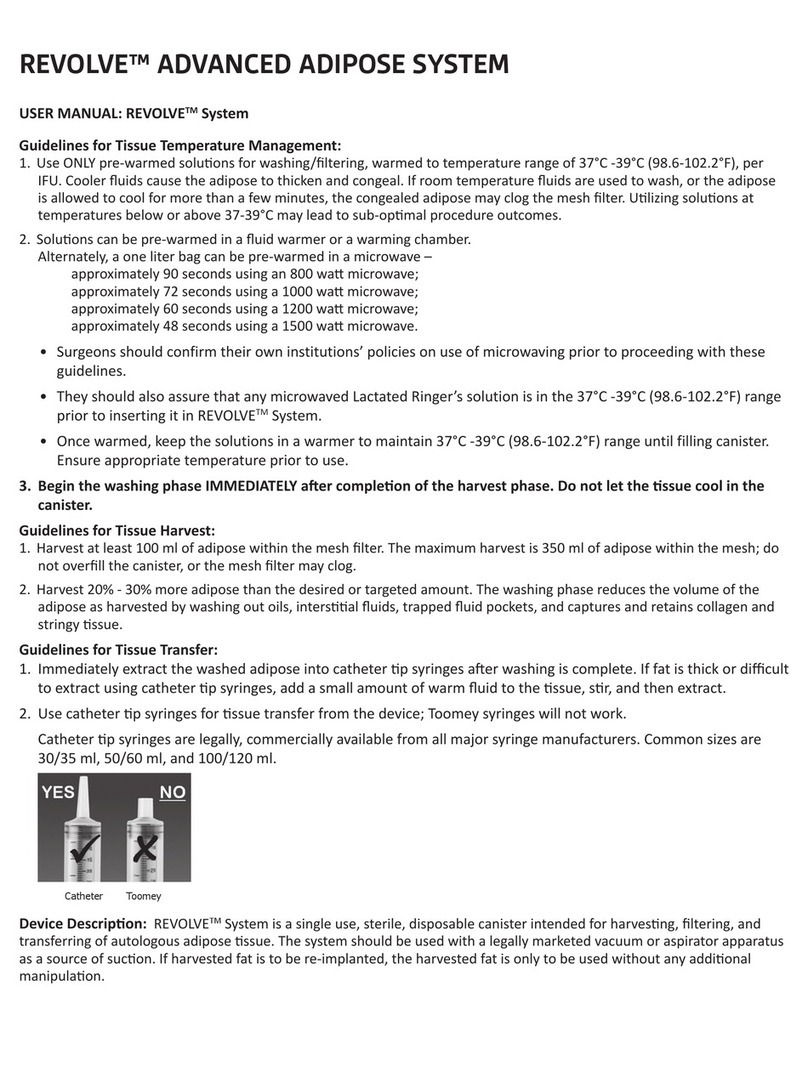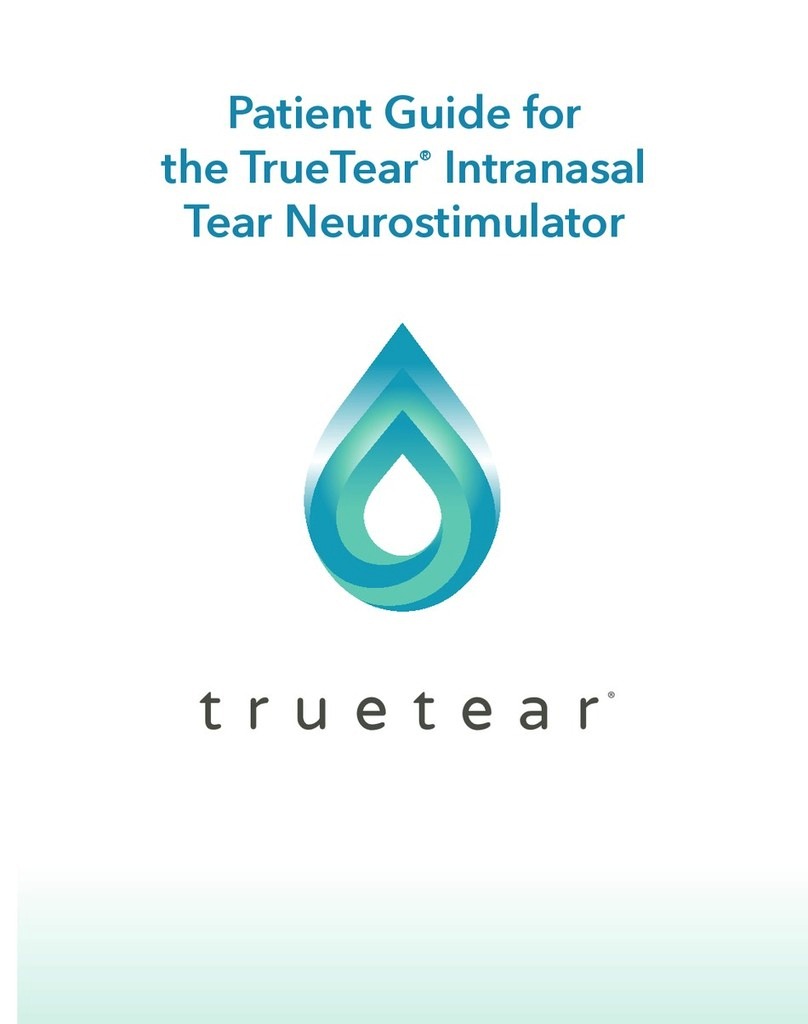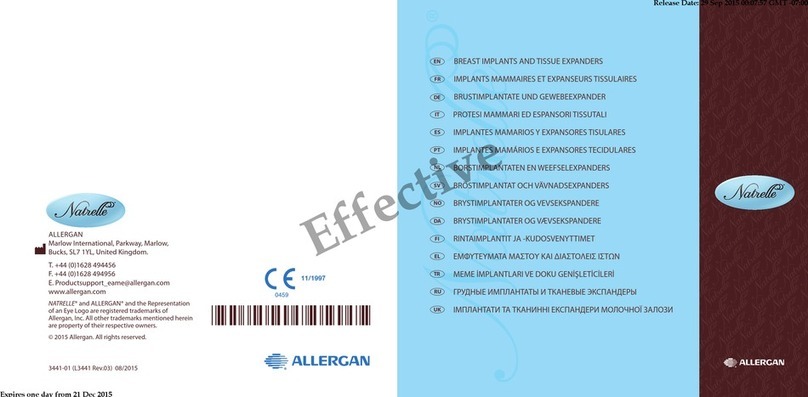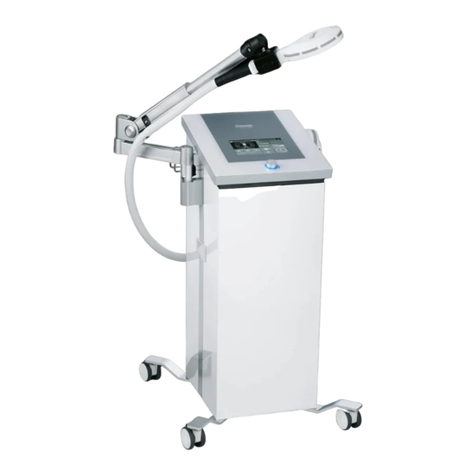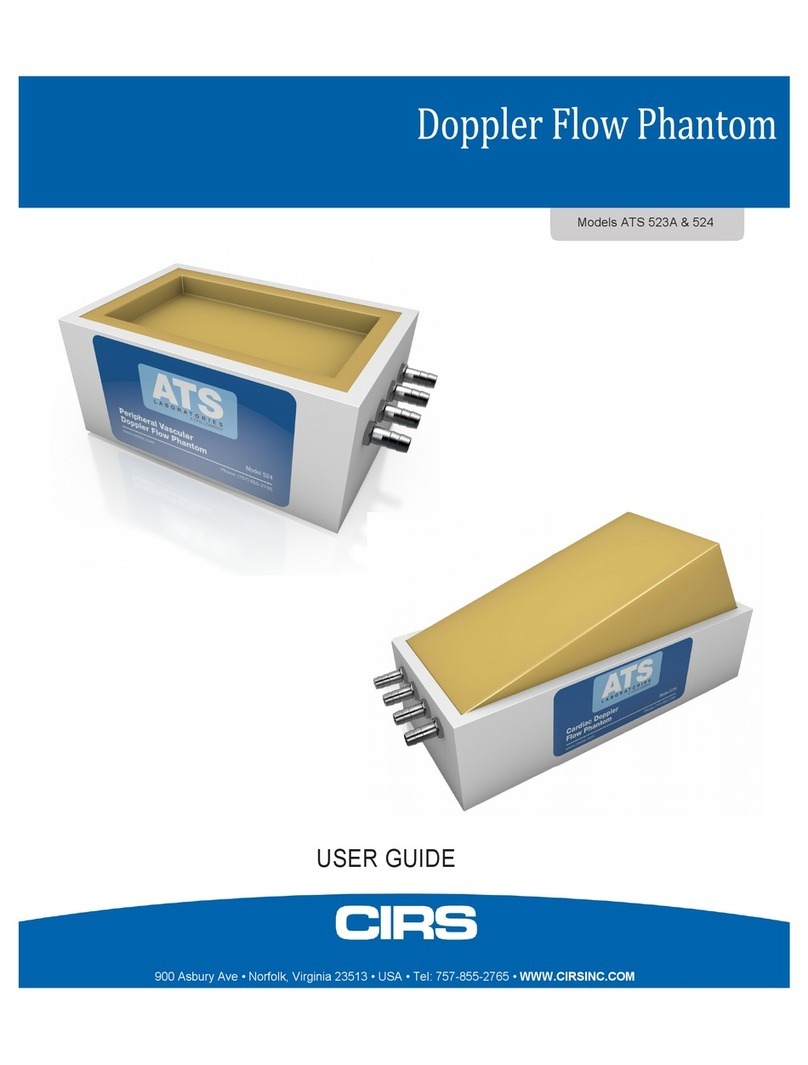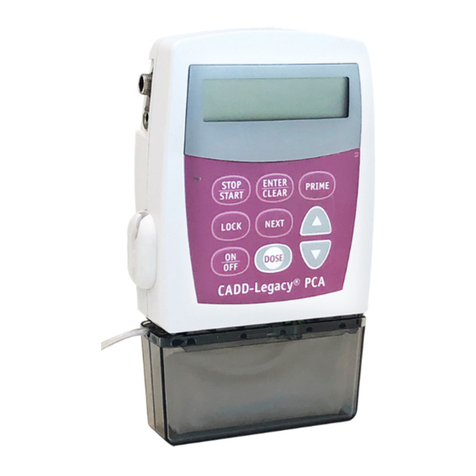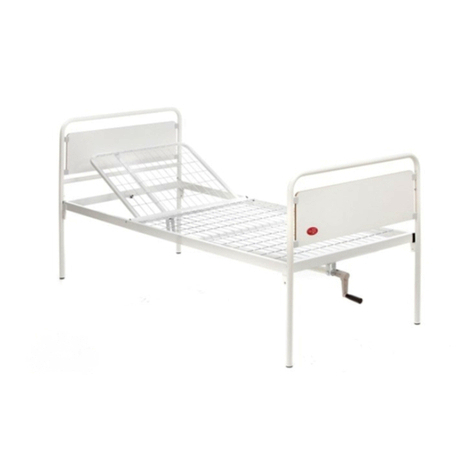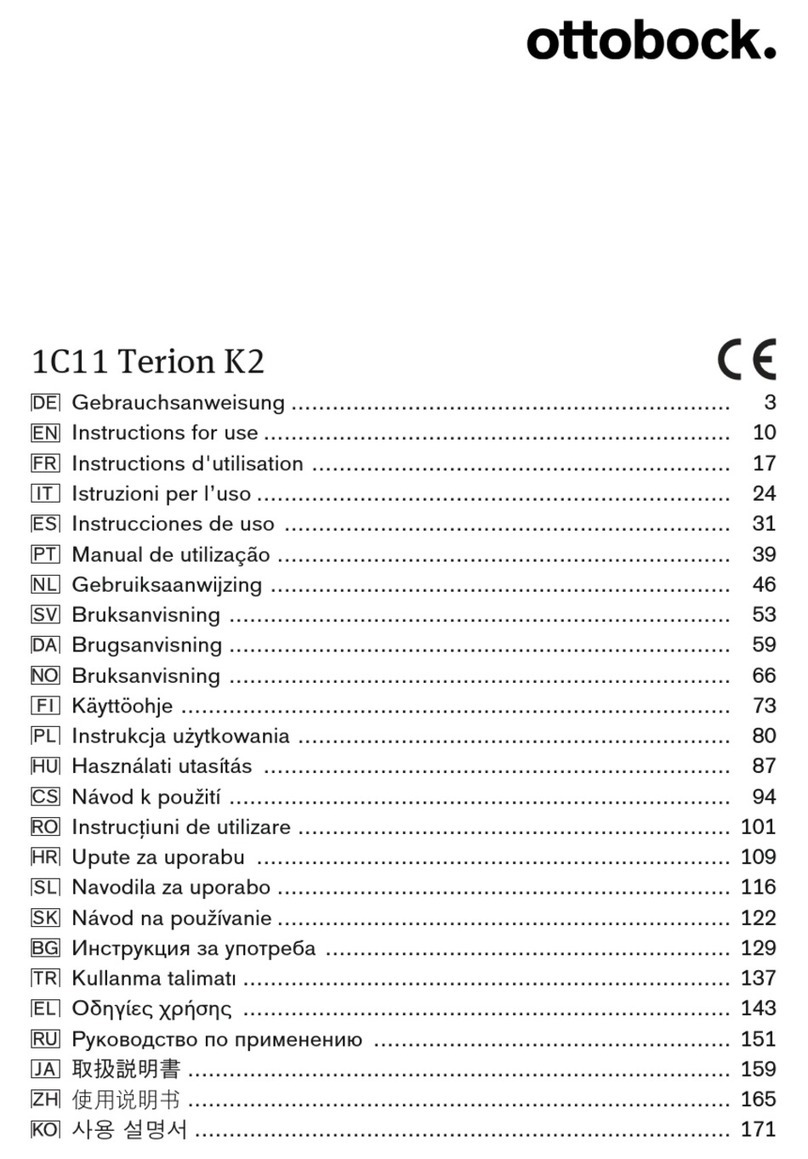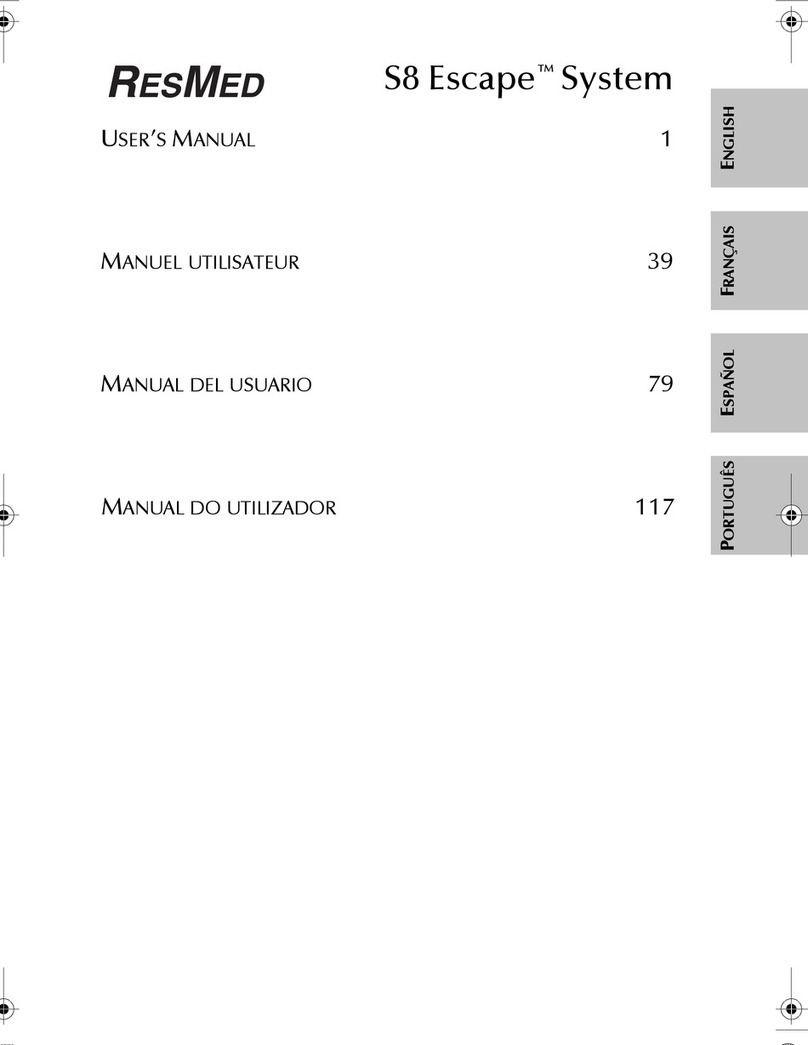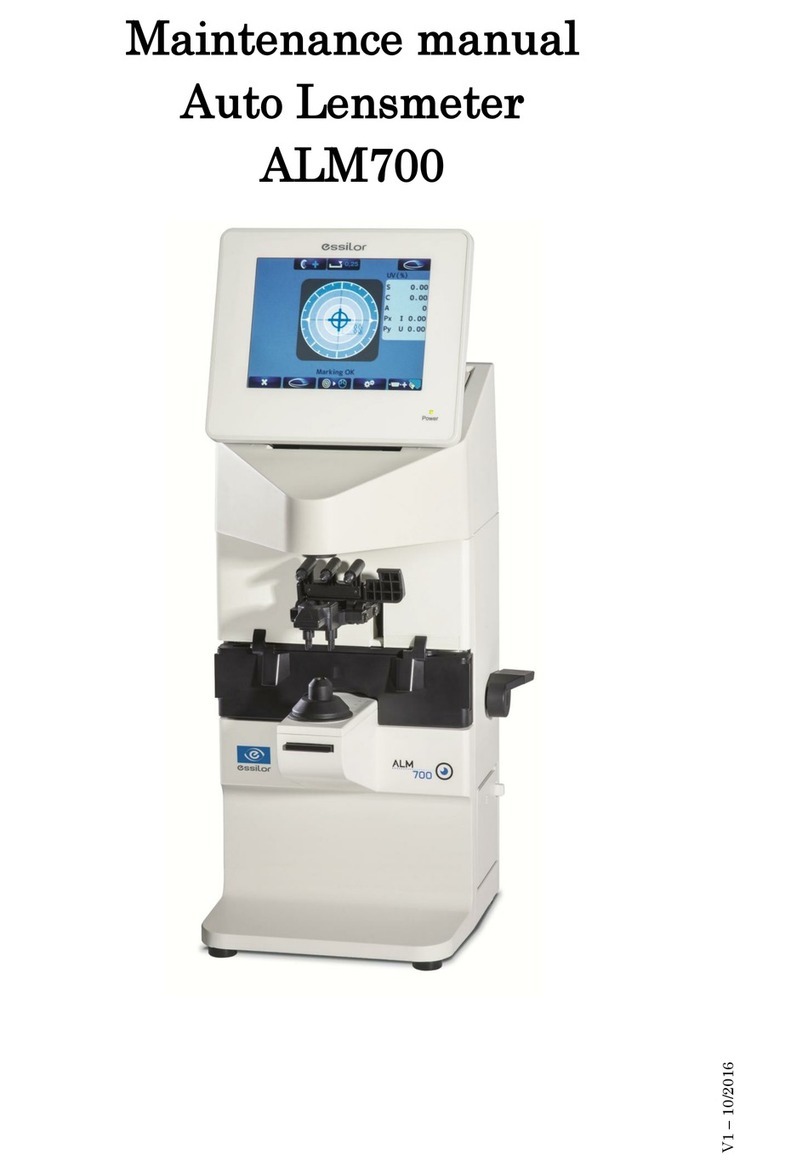Allergan TrueTear User manual

Patient Guide for
the TrueTear®Intranasal
Tear Neurostimulator

Patient Guide for
the TrueTear®Intranasal
Tear Neurostimulator
Please read this entire guide. If you have any questions,
discuss with your provider to make sure you understand
how to use the TrueTear®Intranasal Tear Neurostimulator.
The TrueTear®Intranasal Tear Neurostimulator
(TrueTear®device) provides a temporary increase
in tear production during neurostimulation to
improve dry eye symptoms in adult patients with
severe dry eye symptoms.
Rx Only—Federal law restricts this device to sale by or on
the order of a physician or properly licensed practitioner.
Proper patient training on use of the device is required
before home use.

Glossary....................................................................................................... 2
Introduction ................................................................................................ 4
Facts About Dry Eye Symptoms .......................................................... 4
Indications for Use ................................................................................ 4
Potential Benets of the TrueTear®Device ......................................... 4
Potential Complications With Using the TrueTear®Device .............. 4
Contraindications, Warnings, and Precautions.................................. 5
Contraindications............................................................................ 5
Warnings.......................................................................................... 5
Precautions ...................................................................................... 7
Are You a Good Candidate for Use of the TrueTear®
Intranasal Tear Neurostimulator? ........................................................ 8
Questions to Ask Your Provider........................................................... 8
Summary of Important Information .................................................... 9
Instructions for Use.................................................................................. 10
Overview of the TrueTear®Device Components............................. 10
Charging the Battery .......................................................................... 11
Assembly.............................................................................................. 12
Stimulation........................................................................................... 14
Recommended Stimulation Schedule.............................................. 17
Caring for Your TrueTear® Device....................................................... 17
Disposal and Replacement................................................................ 18
Bluetooth®............................................................................................. 19
FCC Compliance................................................................................. 19
Electrical Specications...................................................................... 20
Electromagnetic Compatibility.......................................................... 20
Environmental Operating Conditions .............................................. 21
Symbols and Markings....................................................................... 21
Summary of Clinical Studies................................................................... 22
Clinical Study OCUN-009—Single Study Visit (one-time use) ........ 22
Clinical Study OCUN-010—6-Month Study ...................................... 23
Warranty Information............................................................................... 26
Exclusions ............................................................................................ 26
Warranty Claim Procedure................................................................. 27
Miscellaneous...................................................................................... 27
No Other Warranty ............................................................................. 28
Contact Information................................................................................. 28
The TrueTear®Intranasal Tear
Neurostimulator Patient Guide
Table of Contents

2
Glossary
Adverse event An undesirable effect associated with use of a medical product.
Base unit The base unit produces the neurostimulation and provides a
connection to the charger.
Cardiac demand pacemaker or debrillator Device (cardiac demand pacemaker) placed in or in close proximity
to (debrillator) the heart to maintain cardiac rhythm.
Clinical studies Clinical studies are conducted to evaluate the use of a drug or
device.
Contraindications Cases where the TrueTear®device should not be used.
Cornea Clear tissue located in the front of the eye covering the colored area
of the eye.
Disposable tip The disposable tip of the TrueTear®device connects to the base unit
and is inserted into the nose.
Dry Eye symptoms
Dry eye symptoms may include, but are not necessarily limited to,
sensitivity to light, grittiness, pain or soreness, blurred vision, and
poor vision. Dry eye symptoms may be caused by advanced age,
contact lens wear, certain medications, eye diseases, other medical
conditions, or environmental factors.
Eligibility criteria Characteristics or criteria used to determine whether a person can
participate in a clinical study.
Hypersensitivity Allergy or reaction to materials that may come into contact with the
skin or to medications taken.
Intranasal Tear Neurostimulator (TrueTear®device) A device that provides small electrical pulses to stimulate
tear production.
Neurostimulation Delivery of small electrical currents to activate the nerves in the
nose.
Precautions
A precaution provides information regarding any special care to
be exercised by the provider and/or the patient for the safe and
effective use of the device.
Schirmer test A test in which a paper strip inserted inside the eyelid for several
minutes to evaluate tear production.
Temporary electrical discomfort Temporary (short-term) discomfort resulting from electrical
stimulation.
Warnings
A warning alerts the user about serious adverse reactions and
potential safety hazards, limitations in use imposed by them, and
steps that should be taken if they occur.

3
Adverse event An undesirable effect associated with use of a medical product.
Base unit The base unit produces the neurostimulation and provides a
connection to the charger.
Cardiac demand pacemaker or debrillator Device (cardiac demand pacemaker) placed in or in close proximity
to (debrillator) the heart to maintain cardiac rhythm.
Clinical studies Clinical studies are conducted to evaluate the use of a drug or
device.
Contraindications Cases where the TrueTear®device should not be used.
Cornea Clear tissue located in the front of the eye covering the colored area
of the eye.
Disposable tip The disposable tip of the TrueTear®device connects to the base unit
and is inserted into the nose.
Dry Eye symptoms
Dry eye symptoms may include, but are not necessarily limited to,
sensitivity to light, grittiness, pain or soreness, blurred vision, and
poor vision. Dry eye symptoms may be caused by advanced age,
contact lens wear, certain medications, eye diseases, other medical
conditions, or environmental factors.
Eligibility criteria Characteristics or criteria used to determine whether a person can
participate in a clinical study.
Hypersensitivity Allergy or reaction to materials that may come into contact with the
skin or to medications taken.
Intranasal Tear Neurostimulator (TrueTear®device) A device that provides small electrical pulses to stimulate
tear production.
Neurostimulation Delivery of small electrical currents to activate the nerves in the
nose.
Precautions
A precaution provides information regarding any special care to
be exercised by the provider and/or the patient for the safe and
effective use of the device.
Schirmer test A test in which a paper strip inserted inside the eyelid for several
minutes to evaluate tear production.
Temporary electrical discomfort Temporary (short-term) discomfort resulting from electrical
stimulation.
Warnings
A warning alerts the user about serious adverse reactions and
potential safety hazards, limitations in use imposed by them, and
steps that should be taken if they occur.

4
This guide is intended to help you decide whether to use and how
to use the TrueTear®device to provide a temporary increase in tear
production and improvement in symptoms. This device provides
small electrical pulses to stimulate production of your own natural
tears. The electrical pulses are delivered by a disposable tip attached
to the TrueTear®device that you will place in your nose for short
periods of time.
Your provider has determined that the TrueTear®device may work
for you. Please read this entire guide and discuss your questions with
your provider. You can then consider the expected benets versus
the risks and make an informed decision.
Facts About Dry Eye Symptoms
Dry eye symptoms may include, but are not necessarily limited
to, sensitivity to light, grittiness, pain or soreness, blurred vision,
and poor vision. Dry eye symptoms may be caused by advanced
age, contact lens wear, certain medications, eye diseases, other
medical conditions, or environmental factors. In some people,
dry eye symptoms may be improved by increasing the amount
of tears produced.
Indications for Use
The TrueTear®Intranasal Tear Neurostimulator provides a temporary
increase in tear production during neurostimulation to improve dry
eye symptoms in adult patients with severe dry eye symptoms.
Potential Benets of the TrueTear®Device
Use of the TrueTear®device will temporarily increase your tear
production and improve your dry eye symptoms, though not all
patients may respond to this device to the same degree.
Potential Complications With Using the TrueTear®Device
Potential complications include the following:
•Nasal pain, discomfort, or burning sensation
•Short-term electrical discomfort
•Nosebleeds
•Trace blood in nostril
• Nose stufness (nasal congestion)
•Excessive sneezing
•Irritation or numbness of the nose
Introduction

5
This guide is intended to help you decide whether to use and how
to use the TrueTear®device to provide a temporary increase in tear
production and improvement in symptoms. This device provides
small electrical pulses to stimulate production of your own natural
tears. The electrical pulses are delivered by a disposable tip attached
to the TrueTear®device that you will place in your nose for short
periods of time.
Your provider has determined that the TrueTear®device may work
for you. Please read this entire guide and discuss your questions with
your provider. You can then consider the expected benets versus
the risks and make an informed decision.
Facts About Dry Eye Symptoms
Dry eye symptoms may include, but are not necessarily limited
to, sensitivity to light, grittiness, pain or soreness, blurred vision,
and poor vision. Dry eye symptoms may be caused by advanced
age, contact lens wear, certain medications, eye diseases, other
medical conditions, or environmental factors. In some people,
dry eye symptoms may be improved by increasing the amount
of tears produced.
Indications for Use
The TrueTear®Intranasal Tear Neurostimulator provides a temporary
increase in tear production during neurostimulation to improve dry
eye symptoms in adult patients with severe dry eye symptoms.
Potential Benets of the TrueTear®Device
Use of the TrueTear®device will temporarily increase your tear
production and improve your dry eye symptoms, though not all
patients may respond to this device to the same degree.
Potential Complications With Using the TrueTear®Device
Potential complications include the following:
•Nasal pain, discomfort, or burning sensation
•Short-term electrical discomfort
•Nosebleeds
•Trace blood in nostril
• Nose stufness (nasal congestion)
•Excessive sneezing
•Irritation or numbness of the nose
•Infection, scrape (abrasion), sore formation (ulceration)
or inammation inside the nose
•Irritation or sensitivity inside the nose
•Lightheadedness
•Headaches
•Sinus pain
•Sore eye
•Facial pain or pain around the eye
•Increased saliva production
•Sensation of teeth vibrating
•Excessive runny nose
•Temporary increase in symptoms associated with
nasal allergies
•Allergic reaction to contact materials
•Potential permanent scarring of the inside of nose with pro-
longed use
Contraindications, Warnings, and Precautions
CONTRAINDICATIONS
Contraindications are situations where it is advisable not to use the
TrueTear®device. If you have any of the following, you should NOT
use the TrueTear®device:
•A cardiac demand pacemaker, implanted or wearable
debrillator, or other implanted metallic or electronic device
(eg, cochlear implant) in the head or neck
•Chronic or recurrent nosebleeds, a bleeding disorder
(eg, hemophilia), or another condition that can lead to
increased bleeding
•A known hypersensitivity (allergy) to the hydrogel material
that comes into contact with the inside of your nose
WARNINGS
Warnings alert the user about serious adverse reactions and
potential safety hazards, limitations in use imposed by them, and
steps that should be taken if they occur, as identied below:
•Follow the Instructions for Use when using the
TrueTear®device.
•Do not use the TrueTear®device if electronic monitoring
equipment is being used. This type of equipment includes
heart monitors or electrocardiogram (ECG) alarms since this
equipment may not operate properly when the TrueTear®
device is being used.

6
Contraindications, Warnings, and Precautions
WARNINGS (continued)
•Do not use the TrueTear®device when in the bath or shower.
•Do not use the TrueTear®device while driving, operating
machinery, or during any activity in which sneezing or watery
eyes may put you at risk of injury.
•Do not apply the TrueTear®device to the neck, chest, or areas
other than the nose.
•Do not continue using the TrueTear®device if your nose is
irritated since further use may cause injury to the tissues inside
your nose.
•Do not use the TrueTear®device within 3 feet of shortwave or
microwave therapy equipment since this equipment may make
the stimulation from the TrueTear®device unstable.
•Do not use the TrueTear® device in the presence of a ammable
anesthetic mixture with air or with oxygen or nitrous oxide as
there is a remote possibility (comparable to the risk of a mobile
phone) it could ignite the gas.
•Use only manufacturer's supplied accessories.
•The TrueTear®device is limited only to the improvement in dry
eye symptoms as the safety and effectiveness in the treatment
of dry eye disease has not been established.
•In a clinical study, the safety and effectiveness of the TrueTear®
device was evaluated over a 6-month period of time. The safety
and effectiveness of the TrueTear®device for longer periods of
use have not been established. Your provider may periodically
check your nose if the TrueTear®device is used over a longer
period of time.
•The clinical study was not designed to evaluate any changes in
nerve sensitivity.
•The safety of the TrueTear®device has not been established in
the following conditions and patient populations:
• Pregnancy
• Patients under 22 years of age
• Nasal (nose) or sinus surgery, including a history of nasal
cautery, or signicant trauma
• Severe nasal airway obstruction (such as severe septal deviation
or inferior turbinate hypertrophy) or vascularized polyp
(abnormal nasal mucosa with dense network of blood vessels)

7
WARNINGS (continued)
• Disabling arthritis, neuropathy, severe dexterity
impairment or limited motor coordination that would
affect your ability to use or handle the TrueTear®device
• Active and severe:
• Systemic allergy
• Chronic seasonal allergies
• Rhinitis or sinusitis requiring treatment such as
antihistamines, decongestants, oral or aerosol steroids
• Untreated nasal infection
PRECAUTIONS
Precautions provide information regarding any special care to be
exercised by the provider and/or patient for the safe and effective use
of the TrueTear®device.
•Consult your provider before using the TrueTear®device.
•If you feel pain, discomfort, or numbness in your nose with
higher levels of stimulation or a longer duration of stimulation,
reduce the level and/or the number of times you use the
TrueTear®device. If symptoms persist, discontinue use and
contact your provider.
•Discard the disposable tip every 48 hours and replace with a
new tip for proper operation and good hygiene.
•Remove any studs, nose rings, or other piercings from the nose
prior to using the TrueTear®device as this could obstruct the
device and/or cause discomfort if the electrical stimulation is
conducted to surrounding areas.
•Do not use prescription eye medications (eye drops, gels,
or ointments) or nasal sprays within 30 minutes before or after
using the TrueTear®device.
•Consult your provider before use if you have suspected or
diagnosed heart disease.
•The TrueTear®device should be kept out of the reach of children.
•If you have a severe fear of placing anything in your nose,
you may not be able to use the TrueTear®device.
•Clean as directed.
•Failure to replace the tip as directed will cause the device to
not work properly.

8
Are You a Good Candidate for Use of the TrueTear®
Intranasal Tear Neurostimulator?
You are a good candidate for the TrueTear®device if you:
•Are at least 22 years old.
•Have dry eye symptoms.
•Are able to use the TrueTear®Intranasal Tear Neurostimulator.
•Do not have a cardiac demand pacemaker, implanted or
wearable debrillator, or other implanted metallic or electronic
device in the head or neck.
•Do not have a known hypersensitivity to the hydrogel material
that contacts the nasal mucosa.
•Do not have chronic or recurrent nosebleeds, a
bleeding disorder or another condition that can lead
to increased bleeding.
Questions to Ask Your Provider
You may want to ask your provider the questions below to help you
decide if the TrueTear®device is right for you.
•What other options do I have for my dry eye symptoms?
• What are the benets of the TrueTear®device?
•Can I use the TrueTear®device as often as I want?
• Will I be able to use articial tears, gels and ointments in
addition to using the TrueTear®device?
•Will I be able to use dry eye drugs in addition to using
the TrueTear®device? Are there any risks if I use the
TrueTear®device with dry eye drugs?

9
Summary of Important Information
•The TrueTear®device provides a temporary increase in tear
production during use resulting in an improvement in dry eye
symptoms in adult patients with severe dry eye symptoms.
•You should not use the TrueTear®device if you have any of the
following conditions:
• A cardiac demand pacemaker, implanted or wearable
debrillator, or other implanted metallic or electronic
device in the head or neck
• Chronic or recurrent nosebleeds, a bleeding
disorder or another condition that can lead to increased
bleeding
• A known hypersensitivity (allergy) to the hydrogel material
that comes into contact with the inside of your nose
•You should follow all instructions to make sure you use the
TrueTear®device correctly.
•Please call 1-800-433-8871 to report an adverse event.

10
Instructions for Use
OVERVIEW OF THE TRUETEAR®DEVICE COMPONENTS
The TrueTear®device consists of four components.
These are:
1A disposable tip, which is inserted into the nasal cavity
and provides the contact surface for the stimulation of
the target tissue in the nose
2A reusable base unit, which produces the neurostimulation
and enables the patient to control the neurostimulation
3A reusable cover to protect the disposable tip
4A charger to recharge the sealed battery inside the base unit
The disposable tip (tip) is connected to the base unit for
stimulation. The tip contains a hydrogel material similar to
materials used in contact lenses. The tip provides the contact
for conducting the stimulation current, which is produced by
the base unit, to the target site on the inside of the nose.
The tip should be removed and replaced every 48 hours.
The reusable cover can be used to protect the tip between uses.
Once the tip is removed, the base unit can be placed onto the
charger to recharge the battery in the base unit. Charge the
base unit every 48 hours or when you change the tip.
All images shown in this guide are for referencing only.
Figure 1. TrueTear®components.
CoverBase unit + disposable tip Charger
Oculeve Intranasal Lacrimal Neurostimulator IFU images
hydrogel
page 1 of C-0146 (A) images
1c 1d
2a
2b

11
CHARGING THE BATTERY
NOTE: Only use the provided AC adapter for attaching the charger.
1
Ensure the base unit is fully charged when using the
TrueTear® device for the rst time.
2Connect the charger to a wall outlet (120 to 240V) using
the micro USB wall adapter and cable (Figure 2).
CAUTION: The AC adapter provides protection from
high voltages and should only be plugged into easily
accessible outlets.
3If the tip is attached to the base unit, remove tip by rocking the
tip away from the buttons—the disposable tip should disconnect
easily. The base unit can then be placed on the charger. An LED
light turns to a steady orange to indicate that the base unit is
charging (Figure 3).
Figure 2. Connecting the charger.
Figure 3. Placement of base unit on the charger.
Charging Charge
Complete
page 9 of C-0146 (A) images
charging charge
complete
7a
7b
7c

12
4 Remember to charge the base unit every 48 hours or when
you change the tip. The charging process should take less than
4 hours. An LED light turns green to indicate that charging is
complete. The base unit may be removed or left on the charger
when charging is complete (Figure 4).
5 If the TrueTear® device was fully charged and used briey, it is
not necessary to wait for the device to fully charge to use.
Figure 4. Remove or leave the base unit in the charger.
Figure 5. Remove the tip from the pouch.
ASSEMBLY
1 Ensure the base unit is fully charged if using the TrueTear®
device for the rst time (see CHARGING THE BATTERY).
2Tear open the tip pouch at notch and remove the tip from the
pouch by grasping the base (as shown in Figure 5). Avoid
touching the hydrogel.
page 4 of C-0146 (A) images
2d
2h
hydrogel
tear at notch to open
Grasp base of disposable
tip to remove from pouch.

13
3 Connect the tip to the base unit by aligning the post on the
underside of the tip with notch on base unit, then rotate
forward until the tip snaps into place, as shown in Figure 6.
IMPORTANT: DO NOT USE A DISPOSABLE TIP FOR MORE
THAN 48 HOURS. Tip should be replaced every 48 hours.
Failure to replace the disposable tip causes the hydrogel
to dry out and the TrueTear®device will not work properly.
Figure 6. Align the tab to the notch for setup. The tip only ts one way.
Grasp base of disposable
tip to remove from pouch.
page 5 of C-0146 (A) images
3a

14
STIMULATION
There are 5 stimulation intensity levels. The base unit vibrates
briey when a button is pressed to indicate an increase or
decrease in stimulation level. The blue LED light will be lit to
indicate the stimulation level selected.
Your provider will conrm that you understand these instructions,
including having you demonstrate the stimulation technique and
the tearing response, prior to prescribing the TrueTear®device and,
if necessary, at subsequent visits:
1 With the TrueTear®device fully assembled, hold the + button
for 5 seconds to turn on the device. The LED indicator lights
on the base unit ash, followed by a green LED light, which
remains lit as shown in Figure 7.
2.Press the + button to select a desired stimulation intensity
level. Blue LED lights show the level selected.
3.Place thumb near buttons of base unit, then insert the tip
into the nose with the buttons pointing towards your lips
and face, as shown in Figure 7.
4.For effective stimulation, insert the tip all the way to the top
and front of the nose, as shown in Figure 8.
Figure 7. Turning on the TrueTear®device and placing it into the nose.
page 6 of C-0146 (A) images
4b1
4c1
4b2
4c2
?!
Device is
“on”

15
Figure 8. Target zone for correct insertion of disposable tip.
5.The + button is for increasing the intensity and the – button
is for decreasing the intensity. You may gradually increase
and adjust intensity (using the + and – buttons) until you
feel a gentle tingling in your nose; this feeling lets you know
that you are stimulating the correct tissue location and tears
form. Stimulation should last no longer than 3 minutes (or
3 sequential cycles), but may be stopped sooner if you are
satised with tear production.
6.There are 5 levels. The base unit vibrates briey when a button is
pressed to indicate an increase or decrease in intensity level. The
blue LED lights are lit to indicate the stimulation level selected
(Figure 9).
Insert tip into your nose,
as far as is comfortable.
Figure 9. Adjust stimulation by pressing the + or – buttons.
Rest thumb on the + or — button.
Press + or — to change levels
if desired.

16
7.Reposition the tip inside the nose for desired stimulation.
The feeling should be mild at its maximum intensity.
8. Use a new tip and try again if you do not feel any sensation.
9.Remove the tip from your nose at any time if you feel
uncomfortable during stimulation.
The TrueTear®device automatically turns off at the
one (1) minute session limit. The device may also be turned
off by pressing the – button for 2 seconds. The device vibrates
and the LED lights turn off to indicate that the power has been
switched off.
If you prefer a longer stimulation time, turn on the TrueTear®
device again if it automatically turns off.
When nished, clean the TrueTear®device with an alcohol wipe,
if needed (see CARING FOR YOUR DEVICE), prior to placing the
cover on to protect the tip between uses (Figure 10).
Figure 10. Cover attached to base unit to protect disposable tip.
10
11
12

17
RECOMMENDED STIMULATION SCHEDULE
Use the TrueTear®device at least twice a day, as needed. Stimulation
longer than 3 minutes (or 3 sequential cycles) is not recommended,
and you should wait for at least 60 minutes before proceeding to the
next application. The device may be used for up to 30 minutes per
24-hour period and has a built-in single-day usage limit of 30 minutes.
If this daily limit has been reached, the TrueTear®device will turn on
and then off immediately. The device will not deliver stimulation.
CARING FOR YOUR TRUETEAR®DEVICE
1 Use alcohol wipes to clean the cover, disposable tip,
and device between uses. Avoid damaging the hydrogel.
2 Use alcohol wipes to clean the durable parts of the device
including the base, charger, and cover (including the interior
of the cover), as shown in Figure 11. Clean the inside of
the cover weekly or more often if needed to ensure
proper hygiene.
Figure 11. Cleaning with alcohol wipes.

18
3 Do NOT place or submerge the base unit, electrical plug,
or charger in water or other liquid (Figure 12).
4 Handle with care. Store the TrueTear®device in a clean, cool,
and dry location. Avoid exposure to extreme temperatures
and humidity.
CAUTION: Exposure to direct heat can cause the hydrogel
in the disposable tip to dry out and may result in ineffective
stimulation. Avoid touching the metal contacts of the base
unit or charger if either part is exposed to high temperature
extremes (such as sitting in a hot car).
The expected service life for the base unit and charger is
3 years from the date of purchase. The expiration date
of the disposable tips is provided on the product packaging.
DISPOSAL AND REPLACEMENT
The base unit, charger, and AC adapter should be returned to the
local distributor for recycling and disposal in accordance with
any applicable local, state, and national regulations for disposal
of electronic equipment, or otherwise returned to your provider
or physician.
The tips may be discarded with regular trash. Contact your
physician or the manufacturer if any portion of the device is not
operating properly or if you need additional supplies.
Figure 12. Do not rinse base unit or charger in water or any other liquid.
page 9 of C-0146 (A) images
6a
6b
Other manuals for TrueTear
2
Table of contents
Other Allergan Medical Equipment manuals
Popular Medical Equipment manuals by other brands
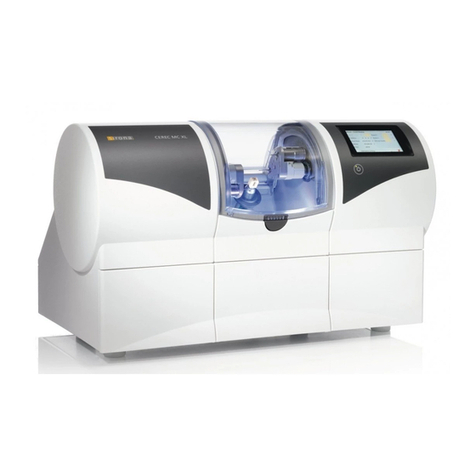
Sirona
Sirona CEREC MC operating instructions
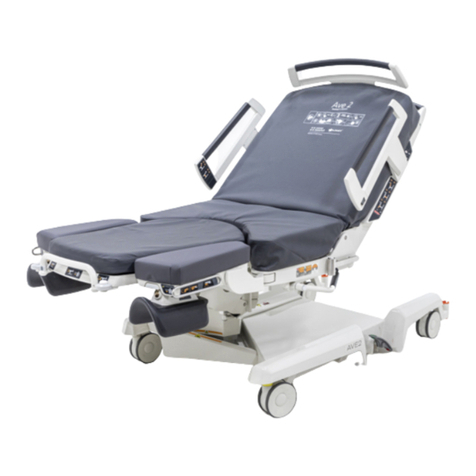
LINET
LINET AVE 2 Instructions for use and Technical description
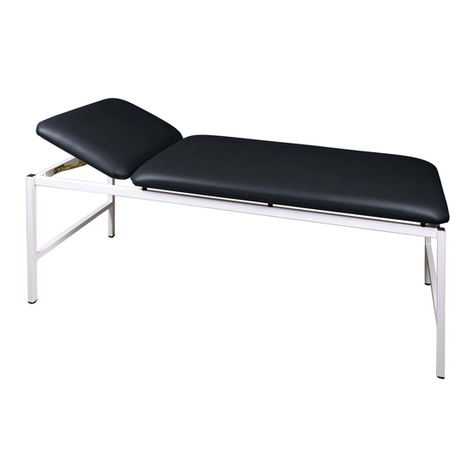
ultraMEDIC
ultraMEDIC ultraREST 200 Instructions for use
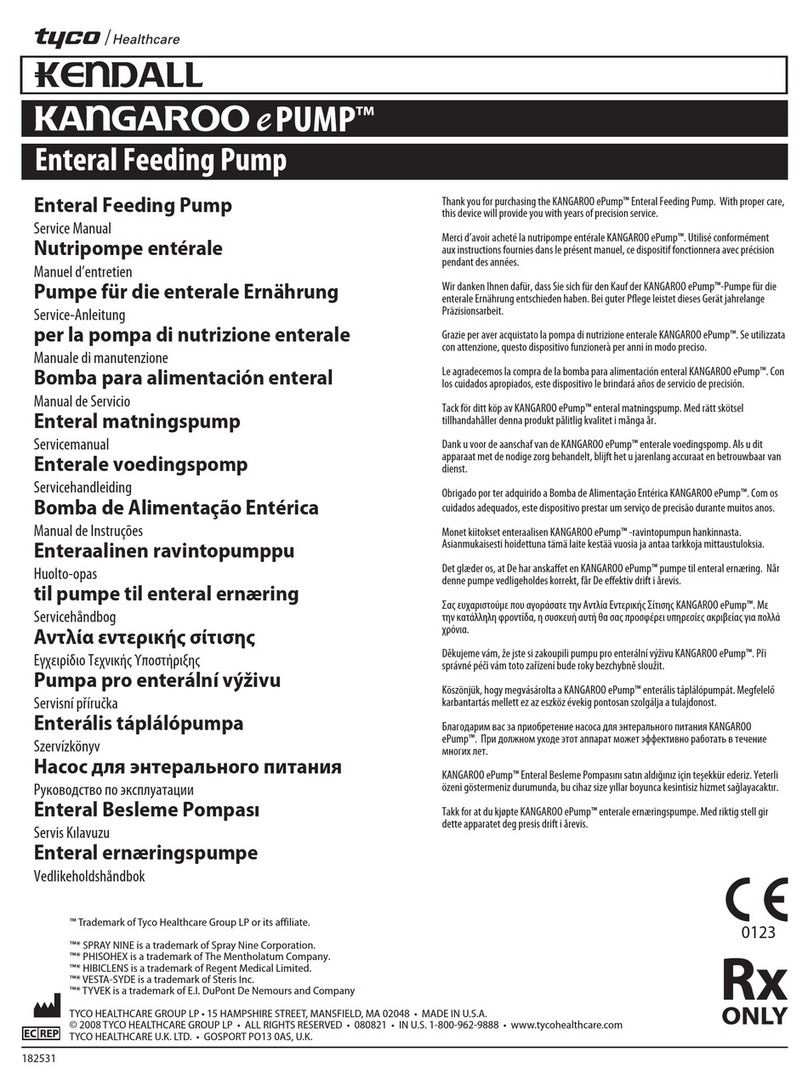
Tyco
Tyco KENDALL KANGAROO ePUMP Service manual
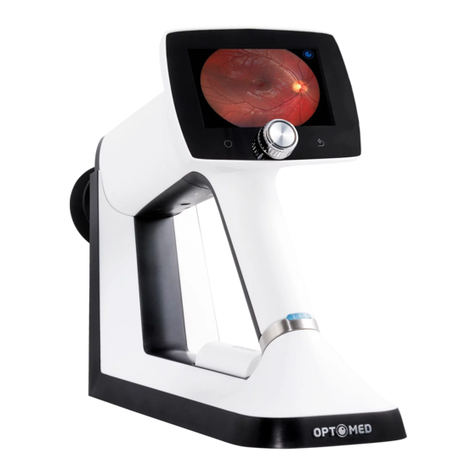
Optomed
Optomed Aurora quick guide
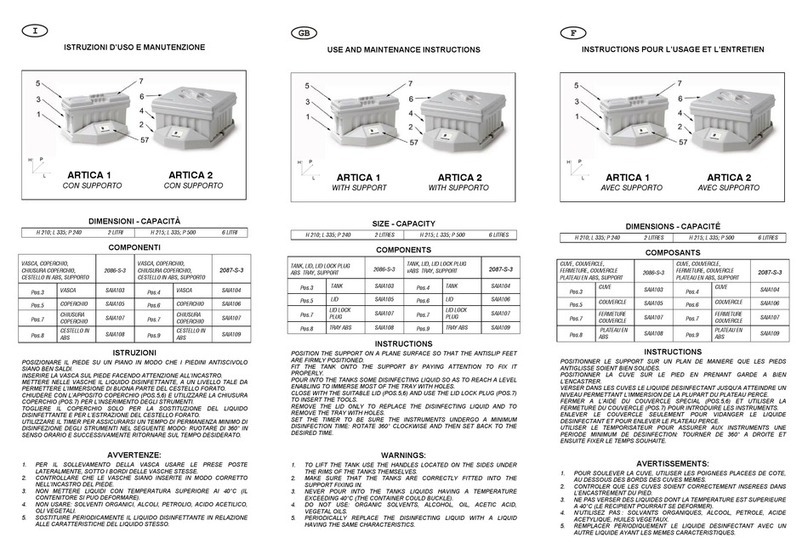
Tecno-gaz
Tecno-gaz ARTICA 1 Use and maintenance instructions

